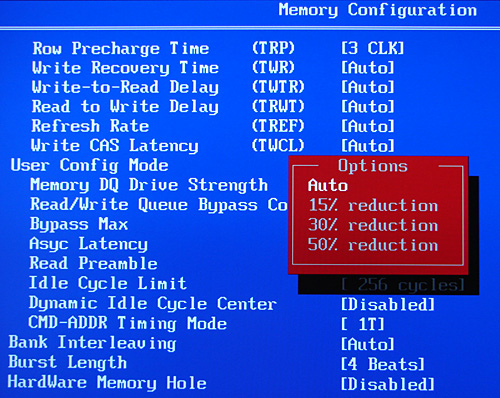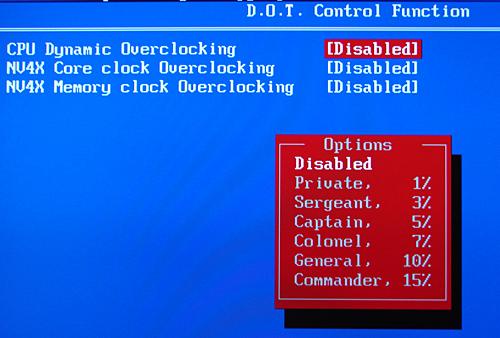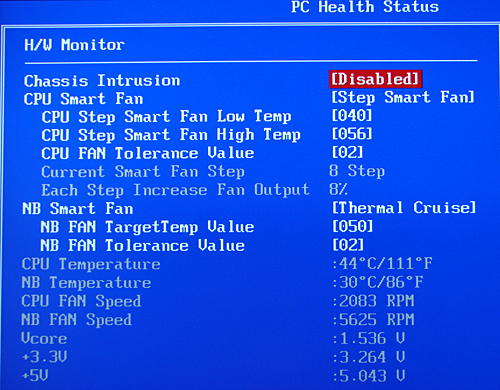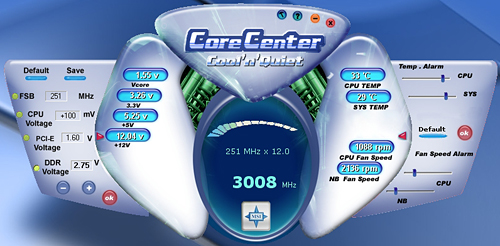Basic Features
The MSI K8N Diamond Plus is an upper-price ranged performance board targeted towards the AMD enthusiast user. The board ships with an extensive accessory package that includes rounded IDE cables, SATA cables, power connectors, SLI bridge card, Firewire backplate, and a 2 USB port/Diagnostic LED backplate. MSI also includes an extensive utility CD and documentation package.

Checking out the BIOS, the Cell Menu section is where most users will spend the majority of their time tweaking this board. While the selection of BIOS options is not as extensive as a DFI board, they are quite numerous and target the enthusiast user. The BIOS allows for CPU voltages up to 2.15V with the additional CPU voltage adjustment along with HTT bus speeds from 200 to 450 MHz. CPU ratios from 5x to 25x are also offered depending upon your CPU type, and the HTT multipliers for the NB and SB links can be independently set from 1X-5X.


The Memory Configuration section allows the user to control memory timing adjustments and dividers. The amount of manual settings available is impressive and without a thorough understanding of each setting, your board could be tuned incorrectly or left inoperable until the BIOS recovery system comes to the rescue. The BIOS allows for Auto settings that will determine the best timing attributes based upon memory type, divider, and bus speeds. We found in our testing the Auto setting would typically adjust the memory clock settings correctly if not a bit relaxed at times. Memory voltage settings are offered up to 3.20V and if you want to void the warranty on the board, MSI provides a switch block that will allow a voltage range from 3.35V to 4.10V.

The D.O.T. Control Function section allows the user to automatically set an overclocking level and then let the system worry about managing the various HTT, CPU, and RAM settings. The system provides for six different dynamic overclocking modes with percentages ranging from 1% to 15%. The BIOS also allows the same settings to be applied to certain NV40 based graphics cards. As a rule, all of these settings are disabled by default.

The PC Health Status section offers the ability to control fan speeds automatically. The BIOS allows the user to set temperature and fan speed targets for the Northbridge and CPU fans, though control and monitoring of the board's chassis fan headers absent. Unlike the BIOS settings from Abit, the MSI BIOS is lacking fan failure notification, automatic temperature-based shutdown settings, and low-RPM alarms.

MSI ships several applications with their board with the most interesting yet disappointing one being the Core Center application. Although advertised as an overclocking utility that one would find very useful, it can only adjust the Dynamic Overclocking settings along with certain voltage settings. The application in essence is a temperature and fan monitoring software utility with limited abilities to change BIOS level settings. However, unlike the BIOS, the user can set fan speed and temperature level alarm conditions for the CPU and Northbridge fans - assuming of course that you're willing to always have Core Center running in the background.
| MSI K8N Diamond Plus Specifications | |
| CPU Interface | 939-Pin Socket supporting AMD Athlon 64 / 64FX / 64X2 |
| Chipset | NVIDIA C51D - North Bridge NVIDIA nForce4 SLI - South Bridge |
| HTT Speeds | 200MHz ~ 450MHz in 0.5MHz increments up to 210HTT, 1MHz increments up to 450HTT |
| CPU Clock Multiplier | Auto, 5x ~ 25x in 1x increments (maximum multiplier dependent upon processor utilized) |
| Memory Speeds | Fixed Dividers - 1/1, 1/2, 2/3, 5/4, 5/6 |
| PCI Bus Speeds | Fixed at 33.33MHz |
| PCI Express Bus Speeds | 100.00MHz ~ 148.4375MHz, various increments |
| LDT Multipliers | Auto LDT to NB, 200MHz, 400MHZ, 600MHz, 800MHz, 1GHz - LDT to NB, NB to SB, SB to NB |
| LDT Link Speed | 8-bit, 16-bit |
| Core Voltage | Startup, 0.800V ~ 1.400V, in .025 increments, Vcore Adjustment +.05V ~ .75mV in .05V increments |
| DRAM Voltage | 2.65V ~ 3.20V, auxiliary switch for 3.35V~4.10V, .05V increments |
| Memory Slots | (4) x DIMM, max. 4GB, DDR 400/333/266, non-ECC, un- buffered memory, Dual Channel Operation supported. |
| Expansion Slots | (2) x PCI-E x16 (each slot operates in 1x16 mode in SLI) (2) x PCI-E x1 (1) x PCI-E x4 (2) x PCI 2.3 |
| Onboard SATA | NVIDIA nForce4: (4) x SATA 3Gb/s Silicon Image - SiL3132: (2) x SATA 3Gb/s (NCQ, Hot Plug) |
| Onboard IDE | NVIDIA nForce4: (2) x UltraDMA 133/100/66/33 |
| SATA/IDE RAID | NVIDIA nForce4: (4) x SATA 3Gb/s - RAID 0, RAID 1, RAID 0+1, RAID 5 SiL3112: (2) x SATA 3Gb/s - RAID 0, RAID 1 |
| Onboard USB2.0 | (10) USB2.0 ports (four I/O panel ports, three board headers for six more ports) |
| Onboard LAN | Marvell 88E1115 PCI Gigabit Ethernet PHY Marvell 88E8053 PCI-E Gigabit LAN Controller |
| Onboard Audio | Sound Blaster Audigy SE, 8-channel HD audio |
| Onboard Firewire | VIA VT6306 IEEE 1394 chipset - 1394A capable |
| Power Connectors | 24-pin ATX 8-pin ATX 12V 4-pin 12V (required for SLI or dual card operation) |
| Back Panel I/O Ports | 1 x PS/2 Keyboard 1 x PS/2 Mouse 1 x Audio I/O Panel 2 x RJ45 LAN 4 x USB 2.0 1 x Serial Port 1 x Parallel Port 1 x IEEE 1394 Port 1 x S/PDIF Coaxial Out 1x S/PDIF Optical Out - TOS Link |
| Other Features | DigiCell- Inclusive Monitoring / Configuration Program Live Update - Windows based driver/bios update utility Core Center - Windows based Monitoring / Overclocking Utility Mega Stick - MSI MP3 Program I-Speeder - Network Monitoring Utility CoreCell- Dynamic Overclocking |
| BIOS | AMI 3.0a (3/21/06) |
The MSI K8N Diamond Plus is an upper-price ranged performance board targeted towards the AMD enthusiast user. The board ships with an extensive accessory package that includes rounded IDE cables, SATA cables, power connectors, SLI bridge card, Firewire backplate, and a 2 USB port/Diagnostic LED backplate. MSI also includes an extensive utility CD and documentation package.

Checking out the BIOS, the Cell Menu section is where most users will spend the majority of their time tweaking this board. While the selection of BIOS options is not as extensive as a DFI board, they are quite numerous and target the enthusiast user. The BIOS allows for CPU voltages up to 2.15V with the additional CPU voltage adjustment along with HTT bus speeds from 200 to 450 MHz. CPU ratios from 5x to 25x are also offered depending upon your CPU type, and the HTT multipliers for the NB and SB links can be independently set from 1X-5X.


The Memory Configuration section allows the user to control memory timing adjustments and dividers. The amount of manual settings available is impressive and without a thorough understanding of each setting, your board could be tuned incorrectly or left inoperable until the BIOS recovery system comes to the rescue. The BIOS allows for Auto settings that will determine the best timing attributes based upon memory type, divider, and bus speeds. We found in our testing the Auto setting would typically adjust the memory clock settings correctly if not a bit relaxed at times. Memory voltage settings are offered up to 3.20V and if you want to void the warranty on the board, MSI provides a switch block that will allow a voltage range from 3.35V to 4.10V.

The D.O.T. Control Function section allows the user to automatically set an overclocking level and then let the system worry about managing the various HTT, CPU, and RAM settings. The system provides for six different dynamic overclocking modes with percentages ranging from 1% to 15%. The BIOS also allows the same settings to be applied to certain NV40 based graphics cards. As a rule, all of these settings are disabled by default.

The PC Health Status section offers the ability to control fan speeds automatically. The BIOS allows the user to set temperature and fan speed targets for the Northbridge and CPU fans, though control and monitoring of the board's chassis fan headers absent. Unlike the BIOS settings from Abit, the MSI BIOS is lacking fan failure notification, automatic temperature-based shutdown settings, and low-RPM alarms.

MSI ships several applications with their board with the most interesting yet disappointing one being the Core Center application. Although advertised as an overclocking utility that one would find very useful, it can only adjust the Dynamic Overclocking settings along with certain voltage settings. The application in essence is a temperature and fan monitoring software utility with limited abilities to change BIOS level settings. However, unlike the BIOS, the user can set fan speed and temperature level alarm conditions for the CPU and Northbridge fans - assuming of course that you're willing to always have Core Center running in the background.










42 Comments
View All Comments
Odeen - Wednesday, April 12, 2006 - link
Hi,I wish you guys would post the EXACT BIOS (and, as necessary, jumper) settings you used to achieve your best overclocks, plus any issues you had with certain settings, etc. I'd love to see the actual notes from the lab, i.e. "Tried this clock skew value, crashed after X minutes."
While this wouldn't solve every overclocker's question, it would at least set us on the right path in optimizing our own systems, in terms of how certain values affect things.
I imagine you guys have a better understanding on what the BIOS settings do, as opposed to us everyday enthusiasts, who operate primarily on coincidences and conjectures. Especially in this age of hyper-tweakable motherboards with more and more components, it'd be really nice to know, for example, whether the hypertransport multiplier between the "NB" and the "SB" should match the chip-NB hypertransport multiplier, or whether that hypertransport bus speed is independent of HTT, and can be kept at 200/5X regardless of HTT value.
Lastly, have you tried the firewall drivers on this board, and does the firewall STILL cause bluescreens and corrupt downloads?
Gary Key - Wednesday, April 12, 2006 - link
We will need a new server to handle the notes sections for some of these boards. ;-)
We are probably heading in this direction shortly, especially for the enthusiast level boards. I will see what we can do on the next enthusiast level board with a table chart and short descriptions on how we arrived at the settings. I will say this, sometimes leaving most of the settings on Auto works best, the board/bios engineers are usually very smart about the default settings and then when you think all is okay, they hit you with a setting that should never be a default item.
We found on the MSI board, the NB-SB, SB-NB, and CPU-NB HT settings had to be synchronized or the board had stability issues. In fact, the CPU-NB default setting was at 800MHz, we had to change the option to manual, and then bump it up to 1000MHz to match the NB-SB and SB-NB HT settings at stock speeds. It does appear we had an average or below average board for the review, the latest retail sample that MSI pulled from their warehouse was able to post at 318HTT x9 with our test components.
If they are more details you would like to know, please comment or email me.
We tried the firewall with the 6.85 drivers. We could only recreate one particular situation that resulted in a corrupt download. It required the use of BitComet, downloading seven plus files (each over 200MB) concurrently, transferring the files to a media folder, and then unzipping a file while three others were still downloading. It only did it once but it did do it, is it NVIDIA or something else? I personally have not experienced any BSODs or corrupt downloads with the latest drivers, a clean load of XP, and staying away from the P2P software.
We have a new NVIDIA Business Platform system on its way so it should be interesting to see the tweaked ActiveArmor suite and driver updates that NVIDIA has been working on extensively over the last ninety days.
Gary Key - Wednesday, April 12, 2006 - link
Just not my week....Should read - If there are more details you would like to know, please comment or email me.
slashbinslashbash - Tuesday, April 11, 2006 - link
PLEASE learn the difference between "discreet" and "discrete".JarredWalton - Tuesday, April 11, 2006 - link
I don't know about you, but I like my audio solutions to be unobtrusive. Nothing worse than audio that gets in your face with static and stuff.... ;)mbhame - Tuesday, April 11, 2006 - link
"Our initial impression of the MSI K8N Diamond Plus upon opening the box is that it has an extensive feature list, cluttered yet clean layout, heat-pipe cooling system, and that the overall quality of components utilized by MSI is very good."...how can a layout be 'cluttered yet clean'?
JarredWalton - Tuesday, April 11, 2006 - link
Cluttered in that there is a LOT of stuff; clean in that it still works and there aren't any issues with connecting everything. It's an oxymoron, like "little giant". :)nullpointerus - Tuesday, April 11, 2006 - link
Now I know how to describe my room.nullpointerus - Tuesday, April 11, 2006 - link
Where are these PCIe 1x cards I've been hearing about? What exactly is available on PCIe besides video/network cards? I've heard that it's going to be a very long, slow transition to PCIe for sound cards due to noise/power issues with the spec.DigitalFreak - Tuesday, April 11, 2006 - link
See http://www.siig.com/productList.asp?pid=1013&c...">this page for examples. I do wish they made PCI-E sound cards though.